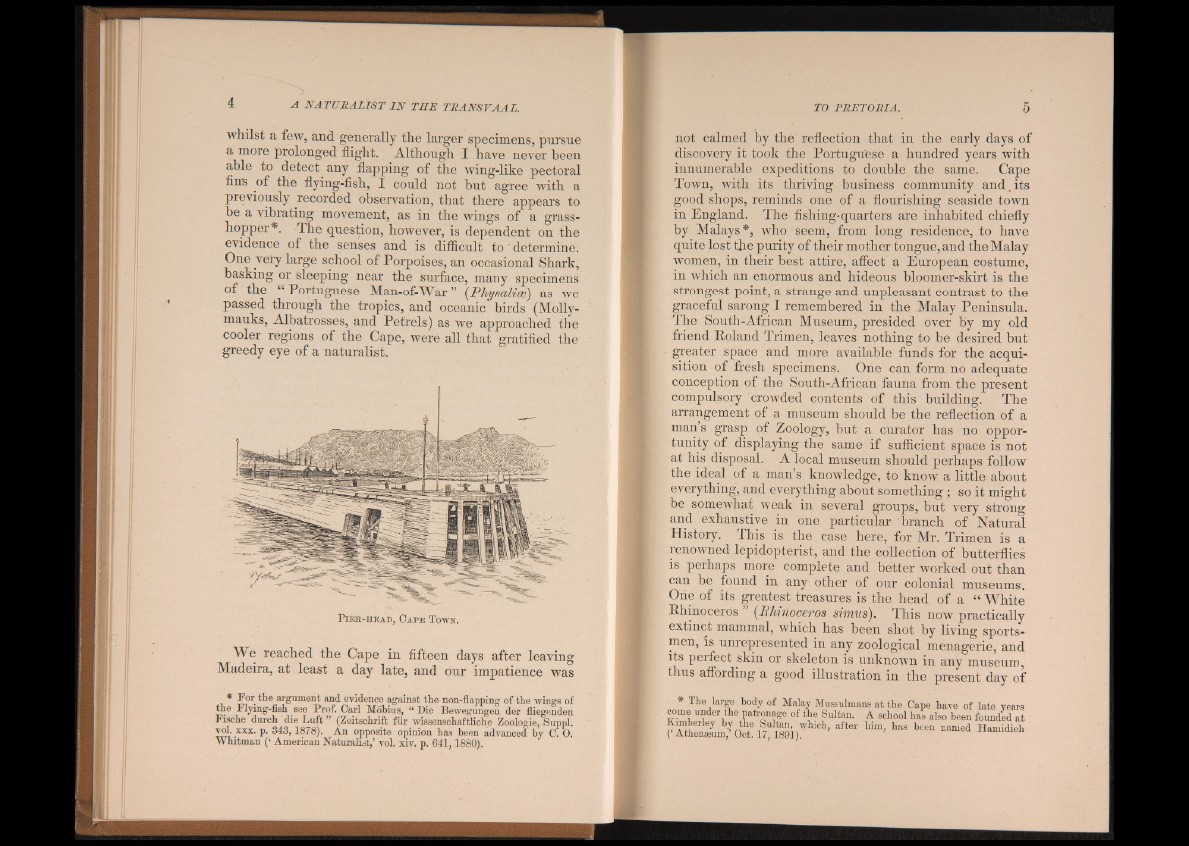
whilst a few, and generally the larger specimens, pursue
a more prolonged flight. Although I have never been
able to detect^ any flapping of the wing-like pectoral
fins of the flying-fish, I could not but agree with a
previously recorded observation, that there appears to
be a vibrating movement, as in the wings of a grasshopper*.
-The question, however, is dependent on the
evidence of the senses and is difficult to ' determine.
One very large school of Porpoises, an occasional Shark,
basking or sleeping near the surface, many specimens
of the. “ Portuguese Man-of-War ” (Physalice) as we
passed through the tropics, and oceanic birds (Molly-
mauks, Albatrosses, and Petrels) as we approached the
cooler regions of the Cape, were all that gratified the
greedy eye of a naturalist.
P ie r -head, Ca p e T own.
We reached the Cape in fifteen days after leaving
Madeira, at least a day late, and our impatience was
* For the argument and evidence against the non-flapping of the wings of
the Flying-fish see Prof. Carl Möbius, “ Die Bewegungen der fliegenden
Fische durch die Luft ” (Zeitschrift für wissenschaftliche Zoologie, Suppl.
vol. xxx. p. 343,1878). An opposite opinion has been advanced by C. 0.
Whitman (‘ American Naturalist/' vol. xiv. p. 641,1880).
not calmed by the reflection that in the early days of
discovery it took the Portuguese a hundred years with
innumerable expeditions to double the same. Cape
Town, with its thriving business community and.its
good shops, reminds one of a flourishing seaside town
in England. The fishing-quarters are inhabited chiefly
by Malays*, who seem, from long residence, to have
quite lost the purity of their mother tongue, and the Malay
women, in their best attire, affect a European costume,
in which an enormous and hideous bloomer-skirt is the
strongest point, a strange and unpleasant contrast to the
graceful sarong I remembered in the Malay Peninsula.
The South-African Museum, presided over by my old
friend Roland Trimen, leaves nothing to be desired but
- greater space and more available funds for the acquisition
of fresh specimens. One can form no adequate
conception of the South-African fauna from the present
compulsory crowded contents of this building. The
arrangement of a museum should be the reflection of a
man’s grasp of Zoology, but a curator has no opportunity
of displaying the same if sufficient space is not
at his disposal. A local museum should perhaps follow
the ideal of a man’s knowledge, to know a little about
everything, and everything about something f so it might
be somewhat weak in several groups, but very strong
and exhaustive in one particular branch of Natural
History. Ihis is the case here, for Mr. Trimen is a
renowned lepidopterist, and the collection of butterflies
is perhaps more complete and better worked out than
can be found in any other of our colonial museums.
One of its greatest treasures is the head of a “ White
Rhinoceros ” (Rhinoceros simus). This now practically
extinct mammal, which has been shot by living sportsmen,
is unrepresented in any zoological menagerie, and
its perfect skin or skeleton is unknown in any museum,
thus affording a good illustration in the present day of
* The large body of Malay Mussulmans at the Cape have of late years
come under the patronage of the Sultan. A school has also been founded at
S S i o t 6 ^ l a o i " h i c h ’ a f t e r h i m ’ h a s b e e a n a m e d H a m i d i e h